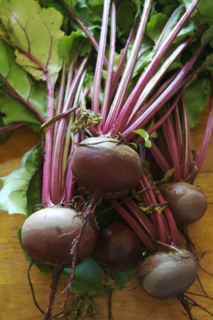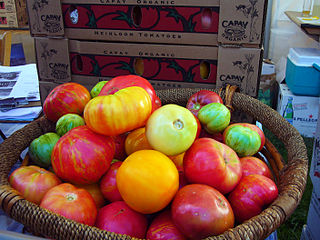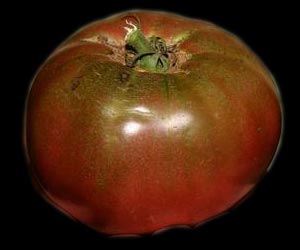Related Research Articles

The beetroot is the taproot portion of a beet plant, usually known in Canada and the USA as beets while the vegetable is referred to as beetroot in British English, and also known as the table beet, garden beet, red beet, dinner beet or golden beet. It is one of several cultivated varieties of Beta vulgaris grown for their edible taproots and leaves ; they have been classified as B. vulgaris subsp. vulgaris Conditiva Group.

The zucchini, courgette or baby marrow is a summer squash, a herbaceous vine whose fruit are harvested when their immature seeds and epicarp (rind) are still soft and edible. It is closely related, but not identical, to the marrow; its fruit may be called marrow when mature.

Lima bean also commonly known as the butter bean, sieva bean, double bean, Madagascar bean, chad bean, or wax bean is a legume grown for its edible seeds or beans.

Borage, also known as a starflower, is an annual herb in the flowering plant family Boraginaceae. It is native to the Mediterranean region, and has naturalized in many other locales. It grows satisfactorily in gardens in most of Europe, such as Denmark, France, Germany, and the United Kingdom, remaining in the garden from year to year by self-seeding. The leaves are edible and the plant is grown in gardens for that purpose in some parts of Europe.The plant is also commercially cultivated for borage seed oil extracted from its seeds. The plant contains pyrrolizidine alkaloids, some of which are hepatotoxic, mutagenic, and carcinogenic.

An heirloom tomato is an open-pollinated, non-hybrid heirloom cultivar of tomato. They are classified as: family heirlooms, commercial heirlooms, mystery heirlooms, or created heirlooms. They usually have a shorter shelf life and are less disease resistant than hybrids. They are grown for a variety of reasons: for food, historical interest, access to wider varieties, and by people who wish to save seeds from year to year, as well as for their taste.

A beef tomato or beefsteak tomato is one of the largest varieties of cultivated tomatoes, some weighing 450 grams (1 lb) or more. Most are pink or red with numerous small seed compartments (locules) distributed throughout the fruit, sometimes displaying pronounced ribbing similar to ancient pre-Columbian tomato cultivars. While popular among home growers for beef sandwich toppings and other applications requiring a large tomato such as toppings on large steaks, beefsteaks are not grown commercially as often as other types, since they are not considered as suitable for mechanization as smaller slicing tomatoes.

Green Zebra is a tomato cultivar with characteristic dark green and yellow stripes. Newer variations blush reddish instead of yellow when ripe. It is more tart than a regular tomato, and it is an early cultivar. Compared to other tomato varieties, it can produce somewhat mealy fruits depending on growing conditions.

Solanum pimpinellifolium, commonly known as the currant tomato or pimp, is a wild species of tomato native to Ecuador and Peru but naturalized elsewhere, such as the Galápagos Islands. Its small fruits are edible, and it is commonly grown in gardens as an heirloom tomato, although it is considered to be wild rather than domesticated as is the commonly cultivated tomato species Solanum lycopersicum. Its genome was sequenced in 2012.
Southern Exposure Seed Exchange (SESE) is a cooperatively-owned seed company. SESE is a source for heirloom seeds and other open-pollinated (non-hybrid) seeds with an emphasis on vegetables, flowers, and herbs that grow well in the Mid-Atlantic region. SESE also supports seed saving and traditional seed breeding through their product line, through lectures and workshops, and by working with over 50 small seed-growing farmers in the Mid-Atlantic and other parts of the United States. SESE publishes an intermittent email newsletter and blog for gardeners, as well as the Southern Exposure Seed Exchange Catalog and Garden Guide.

The tomato is the edible berry of the plant Solanum lycopersicum, commonly known as a tomato plant. The species originated in western South America and Central America. The Nahuatl word tomatl gave rise to the Spanish word tomate, from which the English word tomato derived. Its domestication and use as a cultivated food may have originated with the indigenous peoples of Mexico. The Aztecs used tomatoes in their cooking at the time of the Spanish conquest of the Aztec Empire, and after the Spanish encountered the tomato for the first time after their contact with the Aztecs, they brought the plant to Europe. From there, the tomato was introduced to other parts of the European-colonized world during the 16th century.

Cherokee Purple is the name of a very old variety of tomato that develops a fruit with a deep, dusky-rose color while maintaining a somewhat greenish hue near the stem when mature for eating. The deep crimson interior and clear skin combination give it its distinctive color. It was one of the first of the darker color group of tomatoes sometimes described as "blacks"; the variety Purple Calabash, with its highly irregularly shaped fruits, arose in a very few seed catalogs in the mid 1900s. Southern Exposure Seed Exchange was the first seed company to offer Cherokee Purple, released in limited quantity in 1993.

Tigerella is a bi-colored tomato cultivar, relatively small, 2 to 4 ounces, and early. Upon maturity the fruit is red with yellow stripes, essentially the same as Green Zebra, except that the fruit is red instead of green, and has a sweeter flavor. The colour occasionally varies, in New Zealand for instance, commercially produced Tigerella is dark crimson red with very dark green stripes.

Amy Goldman Fowler is an American billionaire heiress, gardener, author, artist, philanthropist, and advocate for seed saving and heirloom fruits and vegetables. She is one of the foremost heirloom plant conservationists in the US. Goldman has been called "perhaps the world's premier vegetable gardener" by Gregory Long, president of The New York Botanical Garden.

Pear tomato or teardrop tomato is the common name for any one in a group of indeterminate heirloom tomatoes. There are yellow, orange, and red varieties of this tomato; the yellow variety being most common. They are generally sweet, and are in the shape of a pear, but smaller. They are heirlooms and have 3 common other names, such as the "Red/Orange/Yellow Pear Tomato Plants."
The Hillbilly Tomato, scientific name Solanum lycopersicum, is an heirloom cultivar originating from West Virginia in the 1800s. This fruit is considered a beefsteak tomato weighing 1-2 pounds. It is round, heavily ribbed and its skin and flesh is orange- yellow with red streaks. The flavor is described "sweet and fruity" and is low in acid.
The Jubilee cultivar of tomato is heavy yielding, low acid, with golden fruit that grow on indeterminate vines. It was released by Burpee Seeds in 1943.
Azoychka is a yellow Russian beefsteak heirloom tomato. The regular multi-locular structure distinguishes it from brandywine types.
Siberian tomato is a variety of the common tomato plant. It is called "Siberian" because it is capable of setting fruit at 38 degrees Fahrenheit, although it is not particularly frost hardy, despite its name.
References
- ↑ "The Biggest Tomatoes". Heirloom Tomato Plants. Retrieved June 24, 2013.
- "Bicolor Tomatoes". Archived from the original on October 30, 2011. Retrieved November 18, 2011. - ↑ "Heirloom Tomato Seeds - 'Big Rainbow'". Everwilde. Retrieved June 24, 2013.
- ↑ "Big Rainbow Tomato". G H Organics. Archived from the original on July 22, 2013. Retrieved June 24, 2013.
- ↑ http://parkseed.com/tomato-big-rainbow/p/5430/%5B%5D
- 1 2 3 "Big Rainbow Heirloom Tomato". www.specialtyproduce.com. Retrieved April 20, 2019.
